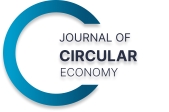You Can’t Go Circular Alone – A Stakeholder Approach to Circular Innovation
Abstract
Circular solutions in industrial companies strongly depend on an interlinked network of diverse stakeholders. Therefore, innovations in the field of a circular economy are difficult to achieve in traditional innovation processes. They rather require an open innovation approach involving internal and external stakeholders in co-creations. This perspective article gives first insights on which stakeholders to involve, how to involve them, and how to overcome barriers. Research- and practice-based experience shows that diverse stakeholders should be selected based on the needs of the specific innovation context and are best involved in a network approach, possibly combined with crowdsourcing. A three-step process is suggested to overcome organizational barriers and to successfully anchor circular innovations in the company. As most firms are not experienced in open circular innovation yet, this article aims at giving them first insights on the topic to support them on their way toward a circular economy.
DOI: https://doi.org/10.55845/HKKE5160
References
Aminoff, A., & Pihlajamaa, M. (2020). Business experimentation for a circular economy – learning in the front end of innovation. Journal of Cleaner Production, 275, 124051. https://doi.org/10.1016/j.jclepro.2020.124051
Brunswicker, S., & Chesbrough, H. (2018). The adoption of open innovation in large firms. Research-Technology Management, 61(1), 35–45. https://doi.org/10.1080/08956308.2018.1399022
Chesbrough, H. W. (2003). Open Innovation: The new imperative for creating and profiting from technology. Harvard Business School Press.
Eisenreich, A., Füller, J., & Stuchtey, M. (2021). Open circular innovation: How companies can develop circular innovations in collaboration with stakeholders. Sustainability, 13(23), 13456. https://doi.org/10.3390/su132313456
Eisenreich, A., Füller, J., Stuchtey, M., & Gimenez-Jimenez, D. (2022). Toward a circular value chain: Impact of the circular economy on a company’s value chain processes. Journal of Cleaner Production, 378, 134375. https://doi.org/10.1016/j.jclepro.2022.134375
Ellen MacArthur Foundation. (2013). Towards the circular economy: Economic and business rationale for an accelerated transition. http://www.ellenmacarthurfoundation.org/assets/downloads/publications/Ellen-MacArthur-Foundation-Towards-the-Circular-Economy-vol.1.pdf
Konietzko, J., Bocken, N. M. P., & Hultink, E. J. (2020). Circular ecosystem innovation: An initial set of principles. Journal of Cleaner Production, 253, 119942. https://doi.org/10.1016/j.jclepro.2019.119942
Lacy, P., & Rutqvist, J. (2015). Waste to wealth: Creating advantage in a circular economy. Palgrave Macmillan.
Tukker, A. (2015). Product services for a resource-efficient and circular economy – a review. Journal of Cleaner Production, 97, 76–91. https://doi.org/10.1016/j.jclepro.2013.11.049
How to Cite This Article
Eisenreich, A., & Füller, J. (2023). You can’t go circular alone – A stakeholder approach to circular innovation. Journal of Circular Economy, 1(1). https://doi.org/10.55845/hkke5160
Copyright
Open Access: This article is licensed under a Creative Commons Attribution 4.0 International License, which permits use, sharing, adaptation, distribution and reproduction in any medium or format, as long as you give appropriate credit to the original author(s) and the source, provide a link to the Creative Commons licence, and indicate if changes were made. The images or other third-party material in this article are included in the article’s Creative Commons licence, unless indicated otherwise in a credit line to the material. If material is not included in the article’s Creative Commons licence and your intended use is not permitted by statutory regulation or exceeds the permitted use, you will need to obtain permission directly from the copyright holder. To view a copy of this licence, visit http://creativecommons.org/licenses/by/4.0/.
Author Notes
Published Details: Received 4 December 2022, Accepted 2 January 2023, available online 20 January 2023
